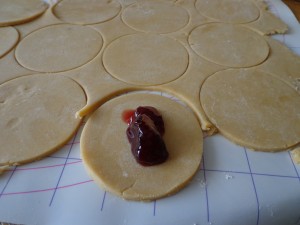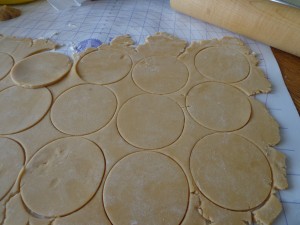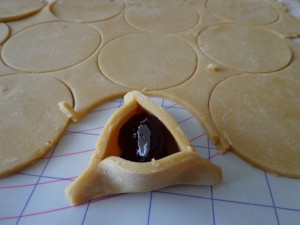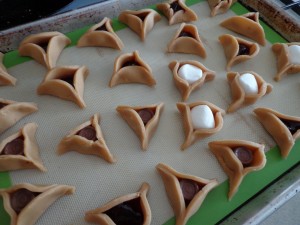 Hamentaschen is a fruit filled pastry baked in honor of the Jewish holiday Purim which occurs late winter/early spring.
Hamentaschen is a fruit filled pastry baked in honor of the Jewish holiday Purim which occurs late winter/early spring.
The Purim celebration is based upon the biblical Book of Esther, which recounts the story of Queen Esther and how she saved the Jewish people from annihilation.
The story begins when King Ahasuerus commands his wife, Queen Vashti, to appear before him and his male guests at a party. She refuses and as a result King Ahasuerus decides to find another queen. His search begins with a royal beauty pageant. The most beautiful young women in the kingdom are brought before the king, and Esther, a young Jewish girl, is selected to be the new queen. Esther is portrayed as an orphan belonging to the tribe of Benjamin. She lives with her cousin Mordechai as a member of the Jewish exiles in Persia. At her cousin’s behest, Esther conceals her Jewish identity from the king.
Not long after Esther becomes queen, Mordechai offends the grand vizier, Haman, by refusing to bow down to him. Haman decides to punish not only Mordechai but all Jews for this slight. He informs King Ahasuerus that the Jews do not obey the king’s laws and that it would be in the kingdom’s best interest to get rid of them. He asks for permission to destroy them, which the king grants. Haman then orders the king’s officials to kill all the Jews – “young and old, women and children” – on the 13th day of the month of Adar (Esther 3:13).
When Mordechai learns of the plot he tears his clothes and sits in sackcloth and ash at the entrance to the city. When Esther learns of this, she orders one of her servants to find out what is troubling her cousin. The servant returns to Esther with a copy of the edict and instructions from Mordechai that she should beg the king for mercy on behalf of her people. This was not a simple request – at the time it had been thirty days since King Ahasuerus had summoned Esther and appearing before him without a summons was punishable by death. But Mordechai urges her to take action anyways, saying that perhaps she became queen so that she could save her people. Esther decides to fast before taking action and requests that her fellow Jews fast along with her.
After fasting for three days Esther puts on her finest clothes and appears before the king. He is pleased to see her and asks what she desires. She replies that she would like the king and Haman to join her at a banquet. Haman is delighted to hear this but is still so upset with Mordechai that he can’t stop thinking about it. His wife and friends tell him to impale Mordechai on a pole if it will make him feel better. Haman loves this idea and immediately has the pole set up. However, that night the king decides to honor Mordechai because earlier in the story Mordecai had uncovered a plot against the king. He commands Haman to put the king’s own robe on Mordecai and to take him around the city on the king’s horse while proclaiming, “This is what is done for the man the king delights to honor!” (Esther 6:11). Haman reluctantly obeys and soon afterward goes to Esther’s banquet.
At the banquet King Ahasuerus asks his wife again, what does she desire? She answers: “If I have found favor with you, Your Majesty, and if it pleases you, grant me my life—this is my petition. And spare my people—this is my request. For I and my people have been sold to be destroyed, killed and annihilated.” (Esther 7:3). The king is outraged that anyone would dare threaten his queen and when he asks who has done such a thing Esther declares that Haman is to blame. One of Esther’s servants then tells the king that Haman had erected a pole upon which he planned to impale Mordechai. King Ahasuerus commands that Haman instead be impaled. He then takes his signet ring from Haman and gives it to Mordechai. Mordechai is also given Haman’s estate and the king gives Esther the power to overturn Haman’s orders.
Esther issues an edict giving Jews in every city the right to assemble and protect themselves against anyone who may try to harm them. When the appointed day arrives, the Jews defend themselves against their attackers, killing and destroying them. According to the Book of Esther, this happened on the thirteenth day of Adar “and on the fourteenth [day] [the Jews] rested and made it a day of feasting and joy.” (Esther 9:18). Mordecai declares that the victory be remembered every year. The celebration is called Purim because Haman cast the “pur” (the lot) against the Jews, yet failed to destroy them.
. These delightfully delicious cookies are triangular in shape after Haman’s hat, to commemorate Queen Esther’s overthrowing the wicked Haman’s intentions and winning the day for her people, the Jewish nation.
Ingredients:
- 2 cups cake flour
- 2 teaspoons baking powder
- 1/2 teaspoon salt
- 1 stick unsalted butter, room temperature
- 1 cups granulated sugar
- 1 teaspoon vanilla extract
- 1 egg
- 2 tablespoon milk
- seedless raspberry jam-filling
- rollo caramel chocolates-filling
- marshmallows-cut in half for a filling
Combine the dry ingredients in a small bowl. Cream the butter and sugar in a large mixing bowl in a stand mixer with the paddle attachment. Add the egg and beat again. Add the vanilla and mix once more. Add the dry ingredients and mix only until combined. Wrap dough in plastic wrap and refrigerate 1 hour.
Preheat oven to 375 degrees. Line cookie sheet with parchment.
Dust work surface with confectionary sugar. Roll out dough to 1/8 inch thick and cut circles.
Place a teaspoon of filling in the center of each circle.
 Pinch three corners together forming a triangle.
Pinch three corners together forming a triangle.
Repeat until the dough is all used up.
Bake 15 to 25 minutes, depending on thickness of cookie, until golden brown.





